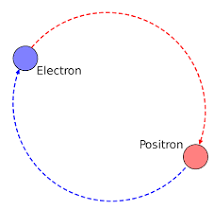-
Posts
916 -
Joined
-
Last visited
-
Days Won
3
Everything posted by martillo
-
Watching the animation but I don't get how it can help in the discussion. Note that for matter waves we have: with the relativistic formula vp = c2/vg and so vp > vg always. with the non-relativistic formula vp = vg/2 so vp < vg always.
-
Yes. I have no problem that in RT is defined the total energy as E = mc2 + KE for m being the "rest mass".
-
Nowhere. RT does not treat "matter waves" but "matter waves" also work for relativistic particles which have considerable high velocities when the non-relativistic equations do not work. We are discussing the "matter waves" comparing both cases, the relativistic and the non-relativistic ones. The problem is that there is a point where both approaches appear to be incompatible. Velocity v is the velocity of the particles. The group velocity of the associated "matter wave" is vg = v. The phase velocity depends in the approach: Non-relativistic approach: vp = v/2 Relativistic approach: vp = c2/v They are not compatible. As v tends to zero the first approach gives vp tending to zero while the second approach gives vp tending to infinite. I'm considering the De Broglie "matter waves" as the "pilot wave" associated to a particle. The variables are the mass and the velocity of the particle. "Matter waves" have phase velocity vp and group velocity vg and vg = v. You are entering the discussion now. If you had read more carefully the earlier posts I wouldn't have to explain all that.
-
A particle at rest has energy, so I don’t see how that would work. A particle at rest has a momentum of mc? I was wrong: p = E/c works for massless particles only like the photon. You are right. Mass plays a role in the "matter waves".
-
My mistake. I should have written vp = c2/v in the relativistic case. No, that is not the discussion. We are not discussing about photons at this point. It's about massive particles and their associated "matter waves" in both the relativistic and the non-relativistic case. As @joigus says the phase velocity is considered a non observable magnitude, is not measurable. I have already seen the "matter waves" said to be not measurable in other places.
-
You are being very clear. You don't need to continue repeating your viewpoint. I can't be more clear too. It is not for the vp phase velocity. Gamma tends to 1, so what? What happens to the relativistic phase velocity vp when v tends to zero? Does it tends to the non-relativistic vp? It doesn't. That is the point. SUMMARYZING: As I have already posted several times, the phase velocity vp of the waves associated to massive particles is defined as (simple way): relativistic case: vp = mc2/v non-relativistic case: vp = v/2 (Where v is the velocity of the particle coincident with the vg group velocity of the waves.) They give incompatible results. They are incompatible definitions. More clear impossible.
-
I perfectly understood the mathematics giving those values for the phase velocity vp in both the non-relativistic and the relativistic cases. The point is that I cannot live with their incompatibility: the non-relativistic case should be a particular case of the relativistic one just considering v << c.
-
I can't... I can't live with things like that. A totally new theory must surge. No other way. Impossible to "weld" current ones. But too much things to question, too much things to demonstrate, a huge task...
-
Is just in vp where a problem arises. It should be solved someway...
-
The root square is a quotient, no pb. All the problem I think is in the different definition for the energy E used in each case: For the non-relativistic case E = KE. For the relativistic case E = mc2 + KE. Just one definition should be used...
-
Yes, that is exactly the point. Returning to the basic relation p = E/vp we have for the phase velocity vp = E/p where: For the non-relativistic case E = KE and when v goes to zero vp = E/p goes to zero. For the relativistic case: E = mc2 + KE and when v goes to zero vp = E/p goes to infinite. Then, for vp, the non-relativistic case is not just the particular case of the relativistic one when v << c.
-
Right. They are derived (quite at the end) in the paper I have already mentioned: https://as.nyu.edu/content/dam/nyu-as/as/documents/silverdialogues/SilverDialogues_Peskin.pdf Yes that sounds strange for me too. Not actually my point: I'm considering that the non-relativistic approach is widely said to be a particular case of the relativistic approach obtained for low velocities (v << c) but this is not the case for the"matter waves" we are talking about. The phase velocity in the non-relativistic case cannot be derived from the relativistic case just considering v << c. Quantum Mechanics predicts (as derived in the paper I mentioned) for the relativistic case a phase velocity = w/k = c2/v while for the non-relativistic case a phase velocity = w/k = v/2 which cannot be derived form the first just by the approximation v << c. I mean, in the non-relativistic case the phase velocity goes to zero with the velocity v going to zero while in the relativistic case it goes to infinite. I don't know if this is just another "paradox" that could actually be explained someway. As for now it looks for me like an incompatibility that surges while trying to reconcile Relativity with Quantum Mechanics. But may be we could be going out of topic with this now so don't worry too much about.
-
Right. The total energy (PE plus KE) is then conserved and would be negligible in the case of the positronium. I have made some calculations giving a total energy of about few 7.2 ev much less than the relativistic energy of the pair (2xmc2) about 1 Mev.
-
What is difficult to grasp for me is that the classical approach is said to be a particular case of the relativistic approach obtained for low velocities (v << c). In the case of the relativistic wave associated to a particle the phase velocity is vp = c2/v while in the classical approach is vp = v/2 what cannot be obtained from the first one for v << c. The two approaches seem to be incompatible. Is that what you mean apparently paradoxical?
-
Right. The article in the link I provided says the same but I wrote it wrongly. Quite all the waves (except transversal ones) can be equated in the form p = E/vp where vp is the phase velocity of the waves. I wrote just v which is the velocity of the particle corresponding to the group velocity of the waves. They are not the same.
-
From Wikipedia: "An electron and positron orbiting around their common centre of mass. An s state has zero angular momentum, so orbiting around each other would mean going straight at each other until the pair of particles is either scattered or annihilated, whichever occurs first. This is a bound quantum state known as positronium." I think that for "ground state" you mean the possible configuration (considering even their spins) of minimum energy between them. They would stay orbiting for some time and they do not annihilate at this state. The state is unstable and the attractive force between the electron and the positron accelerates them towards each other until the annihilation takes place at some distance less than the orbiting radius. Wikipedia article says the orbiting radius and binding energy can be roughly estimated through an analogy to the hydrogen atom but this is not the binding energy precisely at the annihilation which is what I'm referring to. The annihilation distance is less than the orbiting radius and the binding energy at the annihilation is higher than that while orbiting. The binding energy increments as the distance diminishes and they both seems to remain still unknown at the final state of the pair real annihilation.
-
No, it is about the Electric Potential Energy between the electron and the positron which depends in their distance: kq1q2/r. It does exist but the problem is that the distance r at which the annihilation takes place is unknown and the Heisenberg's uncertainty makes it uncertain so actually we cannot determine it. What I observe is that the energy tends to infinite as the distance r tends to zero. Just for instance, if the annihilation distance would be about the Compton-wavelength of the electron (2.42631x10-12 m) then such energy would be about 6x10-17 Joules = 375 ev (electron-volts) what would be about a thousandth of the mass-energy of the electron (mc2 approximately 500 Kev ) and would be negligible. Actually the annihilation distance and the associated Electric Potential Energy are unknown. Nowhere is mentioned about them.
-
Yes, I do understand how an electromagnetic wave is able to infringe a force and so how it can carry momentum while being a massless propagating "perturbation" of the E/M field. Actually my problem was in the relativistic approach to photons but I think I was already clarified now why photons have zero mass also in RT. I meant by "omit" exactly what you say but seems a misspelling could take place and so I must not call it that way. I hope that, with the answers I have received to my questionings, my participation in the thread could have also helped the OP in better understanding the photons...
-
I have already admitted I was wrong in generalizing for massive particles. In the wave-like behavior actually the momentum p appears, not the mass. De Broglie wavelength is actually defined by their momentum p which is different for them (λ = h/p) at same velocity. But for massive particles there is a relation between the momentum p and the mass m... May be I should rethink about what I have said. The point is that in general, waves are not associated to a mass but De Broglie law precisely combines both. Definitely I must rethink about... Better to say that the wave-like behavior also omits the concept of mass although it plays a role in the determination of the wavelength.
-
Nothing simple... In the link I posted after, quite all the waves relate their energy and momentum in the form p = E/v excepting for transversal waves only.
-
No problem for me.
-
I have already found a good answer to my question at: https://as.nyu.edu/content/dam/nyu-as/as/documents/silverdialogues/SilverDialogues_Peskin.pdf Seems the exception is on pure transversal waves which do not propagate. Would be the case of standing waves.
-
Right. The general equation to be applied ever is E2 = (Mc2)2 + (pc)2 and for massive particles p = mv = γMv while for massless ones, like the photon, the factor γ = (1 - v2/c2)-1/2 is undefined for v = c and so must be defined p = E/c. Electromagnetic waves would be massless so p = E/c would hold for them. With analogy, just a question: Would the definition p = E/v apply to any other wave like sound and water waves?



